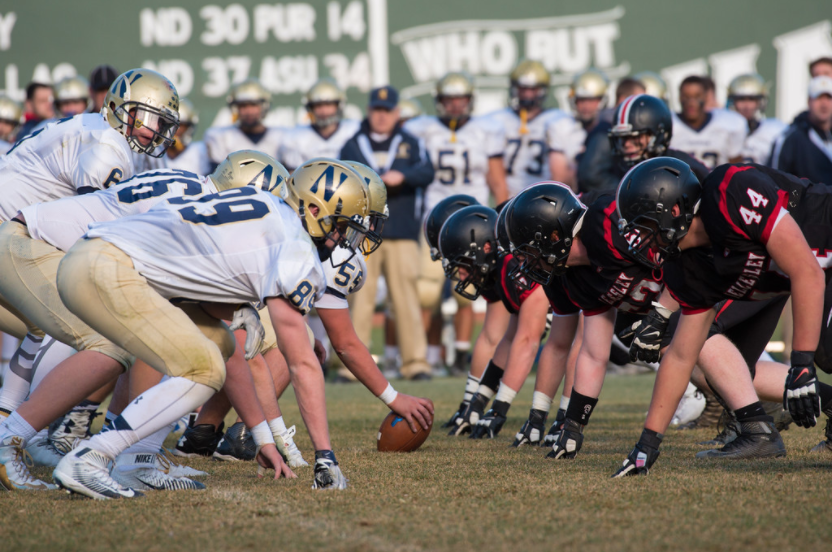Wellesley vs. Needham is the oldest public school football rivalry in the country totaling 134 years.
You don’t have to be in Wellesley long before you find out about the oldest public school football rivalry in the country.
The hero of the first Thanksgiving game in 1882 was Arthur J. Oldham, a Wellesley student of slight build, but capable of great speed. Although he is an unlikely protagonist of the story, it was Oldham who served as captain in the informal football games the boys played at recess at Wellesley’s Gamaliel Bradford High School.
Oldham believed that it would be exciting to take the sport up a notch by challenging the boys of Needham to play a real game and not to just play with themselves like they did most days.
As soon as the Needham opponents accepted the challenge of having a real game, the Wellesley boys began to have second thoughts as they realized how imposing their Needham rivals were.
Then there was a budget crunch. In the 1880s, a football cost $3.50, a then exorbitant price.The high school principal, Frederick Baston, came to the rescue, and organized a fundraiser to pay for the ball.
And so it began, on the brilliant autumn day of November 30, 1882: the match-up that would begin the longest and oldest public school football rivalry in the U.S.. In the shadow of the newly-built Wellesley Town Hall, (having the town of Wellesley been founded one year before) a few dozen people gathered on the field and waited. The crowd grew, along with the excitement, as players and spectators arrived. Today a commemorative boulder, dedicated to Oldham, marks the spot just west of Morton Field, between the present day duck pond and the police station. The tradition that started that day has continued and grown for 134 years.
Later in life Oldham wrote of the event: “The first Needham game was looked upon as a really great sporting event in town… but as the day grew near our boys began to doubt the wisdom of scheduling this game as the Needham boys were bigger than we and some of them were as large as grown men. We were the clear underdogs to win.”
The intimidation continued, as the Needham team arrived at Morton Field on their old-fashioned high-wheeled bicycles. But with the support of their spectators as well as “a number of girl students [who] were there to cheer us to victory,” (as Oldham wrote) the team sent its captains in for the coin toss.
Wellesley won the toss, electing to kick off from the upper end of the field. “As I recall,” Oldham wrote, “the Wellesley squad was short two men, so I immediately dispatched my brother John into the crowd to recruit two players. During the heat of this game, one of the Wellesley players entirely removed the back of his opponent’s jersey, so that the player in question had to finish the game in his overcoat.”
Years later, that shirtless Needham player, A.H. Lawrin, wrote a letter to Oldham to help establish the Wellesley-Needham claim to the schoolboy record.
Wellesley won that first game 4-0, and thus the annual tradition began. Needham offered to host the return match the next year at Green Field. (The Needham team triumphed in that 1883 game the following year, 1-0.)
The Wellesley team members donned their first official uniforms in 1888. Before that, both teams wore thin shirts and lightweight bicycle breeches and stockings to all of their games. The outfits that were purchased by the school in 1888, however, had to wait to be used in game, when the Thanksgiving game was cancelled “because of the questionable academic standing of some members of the Needham squad,” wrote Ed Powers in his 1965 book: The History of Wellesley High School’s Red Raiders, 1882-1965. “It was reported that they had some semi-professional and college material, in addition to the fact that the sire of one of the players decided to revert back to his high school days and rejoin the squad.”
The scheduling of Thanksgiving games in the early years was subject to uncontrollable events.. In 1903, a flu epidemic severely crippled both teams; the game went on, but it ended without a score. In 1914, in the face of a powerhouse Wellesley team that eventually beat Everett for the state championship, Needham called off the game. Play was also discontinued in 1917 and 1918, during the World War I.
With no school financing for the football games or any school sports, funds for sports were raised through collections, dances and donations, in the early years of the rivalry. Parents furnished uniforms and helmets. “In those days as soon as the cool autumn weather came, someone in school would start a paper asking the boys to chip in a quarter for a new football,” wrote Oldham. “As soon as the school could raise the three or four dollars required to purchase the ball, a large round rubber ball was purchased.”
The school department assumed responsibility for all sports in 1923, and eventually varsity and intramural sports became an integral part of school programs with the advent of the High School Athletic Associations.
Legends grow from stories of great individual heroics, feats of daring adversity, and even comic events. The chronicles of the history of Wellesley football continue to be filled with stories of the more extraordinary events.
In 1887, the temperature was 11 degrees below zero the morning of the game. The school officials decided that the contest should be called off, but the players insisted upon going on with it. By the time of the kickoff, the temperature hovered around the two-below mark. According to Oldham’s later description: “Many of the residents of both towns are still chortling over the events which resembled the antics of a comic opera. During the course of the game, when a Needham player managed to get himself into the clear and was on his way to an apparent touchdown, the Wellesley fans would swarm on the field and send the young man crashing to the turf. Similarly, if a Wellesley player shook himself loose he was accorded the identical treatment from the Needham fans.”
Official rules soon brought an end to audience participation, and a few years later one of the players, Alvin Hooker, actually distributed rulebooks during the game to try to encourage order.
The 1896 game came perilously close to being a washout. During the opening kickoff the treasured football was launched into the crowd and disappeared. Players were sent out to canvas the town in search of a new ball and luckily play resumed a half-hour later. Another year, when a football ended up in the crowd, it was deflated and flat when it was returned to the field.
In 1940 a blizzard forced the postponement of the Thanksgiving Day game, which finally had to be played at Newton, where the field had been plowed by horses and covered with straw.
In a game in the 1940s, Tom “Tiger” Furdon ran over 100 yards (but actually accumulated a total of nearly 200 yards) for a touchdown. First he ran forward to the 50-yard line and was chased back to his goal line. There he began his run back down the entire length of the field to score. Also during that era, Len Maccini made two 90-yard punts in one game.
In 1941 Wellesley quarterback Bob McIntyre protected his team’s lead by deliberately fading back into his end zone. Although he gave Needham two safeties, he preserved the Wellesley victory, 6-4.
The Raiders have a lifetime record against Needham of 60-58-9, 127 games in all, since 1882.
This year though, Wellesley will go into the Thanksgiving game with an impressive 9 and 1 record, their only loss coming in the playoffs to state powerhouse, Bridgewater-Raynham. The Raiders will play the Needham Rockets once again, who have a record of 5 and 5 this year.
Coming into the game, Coach Jesse Davis and the team are looking forward to strong senior leadership and a great defensive core to give the team the upper hand against rivals Needham come Thursday at 10:00 AM in Needham. After their historic rivalry allotted them a Thanksgiving game last year at Fenway Park, only to lose to Needham by a touchdown, and having lost 7 of the last ten Thanksgiving games against them, the Raiders are especially hungry to get a win, take back the Gorman Trophy and send off the senior class right.


Wellesley did not defeat Everett in 1914. The 1914 Everett team won the national title; scoring 600 points and giving up 0.
[…] the oldest one among public schools, the Wellesley and Needham football rivalry that began in 1882 is historic. The Raiders got stuffed […]
[…] the oldest one among public schools, the Wellesley High School and Needham High School football rivalry is historic. Commemorating this […]
[…] If all this has you feeling nostalgic, check out the Wellesley High School Bradford’s piece, by Sports Editor Owen Zides, on the history of the Wellesley-Needham football rivalry. […]
Great article Owen. The historical facts are incredible. Great way to start my thanksgiving morning.